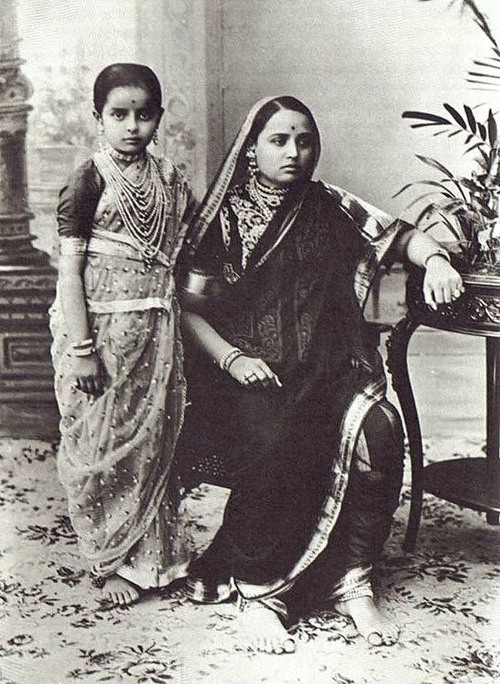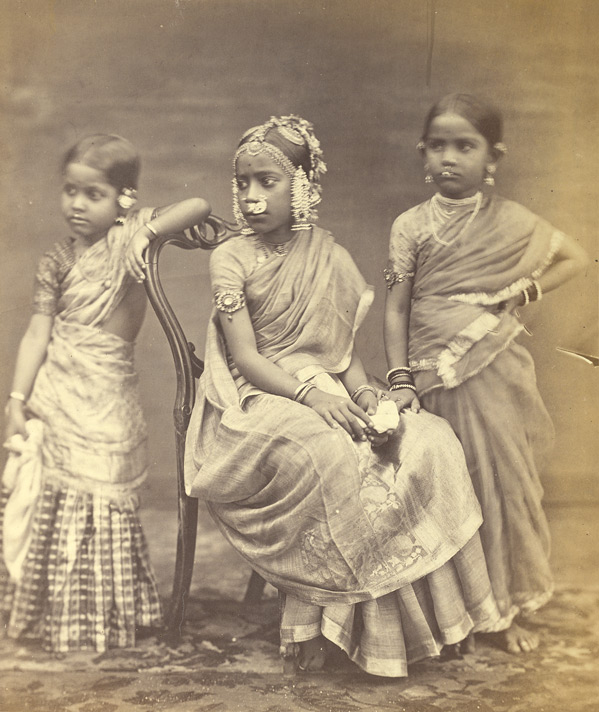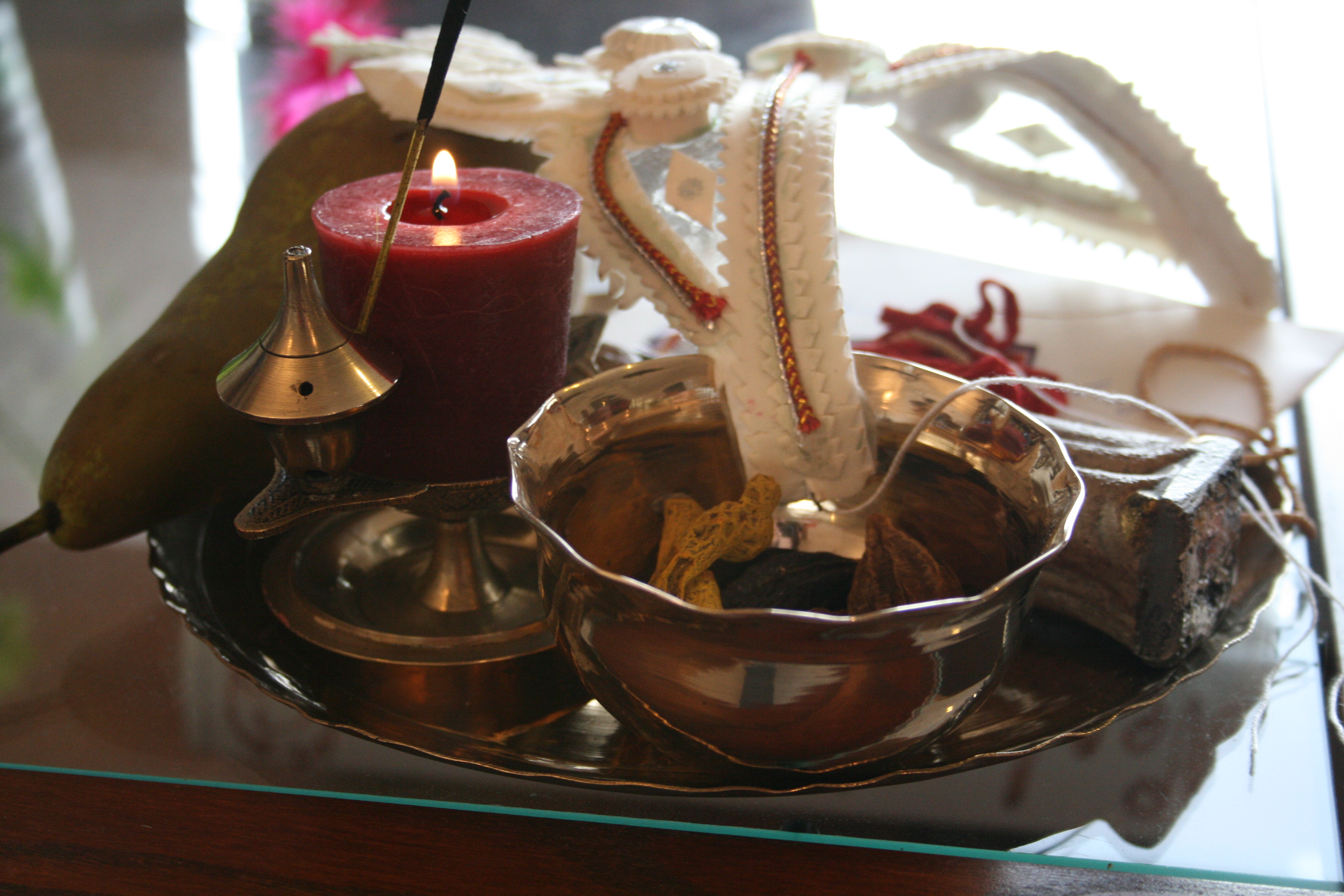|
Langa Voni
A langa voni (also called "''pavadai daavani''" in Tamil or "''langa daavani''" in Kannada) is a traditional dress worn in South India by girls between puberty and marriage. It is also known as the ''two-piece sari'' or ''half sari''. Girls younger than this may wear it on special occasions. It comprises a '' langa'' or ''paavadai'', a skirt which is tied around the waist using string, and a ''voni'', ''oni'', or ''daavani'', which is a cloth usually in length. The ''voni'' is draped diagonally over a ''choli'' (a tight fitting blouse, the same as that worn with a sari). Usually, the garment is woven with cotton or silk. A variant of this is the ''ghagra choli'' of North India (the difference between the two being the direction of draping the ''voni'' or ''dupatta''). The modern day "lehenga-style sari", worn by Indians across the subcontinent mainly for special occasions, is inspired by the langa voni. Dress The half sari facilitates the transition from the childhood ''paava ... [...More Info...] [...Related Items...] OR: [Wikipedia] [Google] [Baidu] |
Tamil Language
Tamil (; ' , ) is a Dravidian language natively spoken by the Tamil people of South Asia. Tamil is an official language of the Indian state of Tamil Nadu, the sovereign nations of Sri Lanka and Singapore, and the Indian territory of Puducherry. Tamil is also spoken by significant minorities in the four other South Indian states of Kerala, Karnataka, Andhra Pradesh and Telangana, and the Union Territory of the Andaman and Nicobar Islands. It is also spoken by the Tamil diaspora found in many countries, including Malaysia, Myanmar, South Africa, United Kingdom, United States, Canada, Australia and Mauritius. Tamil is also natively spoken by Sri Lankan Moors. One of 22 scheduled languages in the Constitution of India, Tamil was the first to be classified as a classical language of India. Tamil is one of the longest-surviving classical languages of India.. "Tamil is one of the two longest-surviving classical languages in India" (p. 7). A. K. Ramanujan described it as "the on ... [...More Info...] [...Related Items...] OR: [Wikipedia] [Google] [Baidu] |
Chiffon (fabric)
Chiffon (; , , from the French word ' which means "cloth or rag"; Arabic ' transparent, diaphanous, translucent fabric, or gauze; ( ' s.th.) to shimmer through, reveal) is a lightweight, balanced plain-woven sheer fabric, or gauze, like gossamer, woven of alternate S- and Z-twist crepe (high-twist) yarns.Kadolph, Sara J., ed.: ''Textiles'', 10 th edition, Pearson/Prentice-Hall, 2007, , p. 230. The twist in the crepe yarns puckers the fabric slightly in both directions after weaving, giving it some stretch and a slightly rough feel. Characteristics Chiffon is a lightweight fabric which is associated with elegance and luxury; it drapes well and has a shimmery and sheer appearance. Under a magnifying glass, chiffon resembles a fine net or mesh, which gives it some transparency. Chiffon can be produced out of natural and synthetic fibres. Silk chiffon was very expensive, and it is with the development of synthetic chiffon, such as nylon chiffon, polyester chiffon, and rayo ... [...More Info...] [...Related Items...] OR: [Wikipedia] [Google] [Baidu] |
Saris
A sari (sometimes also saree or shari)The name of the garment in various regional languages include: * as, শাৰী, xārī, translit-std=ISO * bn, শাড়ি, śāṛi, translit-std=ISO * gu, સાડી, sāḍī, translit-std=ISO * hi, साड़ी, sāṛī, translit-std=ISO * kn, ಸೀರೆ, sīre, translit-std=ISO * knn, साडी, कापड, चीरे, sāḍī, kāpaḍ, cīrē, translit-std=ISO * ml, സാരി, sāri, translit-std=ISO * mr, साडी, sāḍī, translit-std=ISO * ne, सारी, sārī, translit-std=ISO * or, ଶାଢ଼ୀ, śāṛhī, translit-std=ISO * pa, ਸਾਰੀ, sārī, translit-std=ISO * ta, புடவை, puṭavai, translit-std=ISO * te, చీర, cīra, translit-std=ISO * ur, ساڑى, sāṛī, translit-std=ISO is a women's garment from the Indian subcontinent, that consists of an un-stitched stretch of woven fabric arranged over the body as a robe, with one end tied to the waist, while ... [...More Info...] [...Related Items...] OR: [Wikipedia] [Google] [Baidu] |
Hindu Religious Clothing
Hindus (; ) are people who religiously adhere to Hinduism.Jeffery D. Long (2007), A Vision for Hinduism, IB Tauris, , pages 35–37 Historically, the term has also been used as a geographical, cultural, and later religious identifier for people living in the Indian subcontinent. The term ''"Hindu"'' traces back to Old Persian which derived these names from the Sanskrit name ''Sindhu'' (सिन्धु ), referring to the river Indus. The Greek cognates of the same terms are "''Indus''" (for the river) and "''India''" (for the land of the river). The term "''Hindu''" also implied a geographic, ethnic or cultural identifier for people living in the Indian subcontinent around or beyond the Sindhu (Indus) River. By the 16th century CE, the term began to refer to residents of the subcontinent who were not Turkic or Muslims. Hindoo is an archaic spelling variant, whose use today is considered derogatory. The historical development of Hindu self-identity within the local I ... [...More Info...] [...Related Items...] OR: [Wikipedia] [Google] [Baidu] |
Indian Clothing
Clothing in India is dependent upon the different ethnicities, geography, climate, and cultural traditions of the people of each region of India. Historically, male and female clothing has evolved from simple garments like kaupina, langota, achkan, lungi, sari, well as rituals and dance performances. In urban areas, western clothing is common and uniformly worn by people of all social levels. India also has a great diversity in terms of weaves, fibers, colours, and material of clothing. Sometimes, color codes are followed in clothing based on the religion and ritual concerned. The clothing in India also encompasses the wide variety of Indian embroidery, prints, handwork, embellishment, styles of wearing clothes. A wide mix of Indian traditional clothing and western styles can be seen in India. History File:Mohenjo-daro Priesterkönig.jpeg, Statue of "Priest King" wearing a robe, Indus Valley civilisation. File:Didarganj Yakshi statue in the Bihar Museum.jpg, The Didarganj Ya ... [...More Info...] [...Related Items...] OR: [Wikipedia] [Google] [Baidu] |
Ghagra Choli
Ghagra choli (also known as lehenga choli and locally as chaniya choli) is a type of ethnic clothing for women from the Indian Subcontinent, notably in the Indian states of Rajasthan, Gujarat, Madhya Pradesh, Uttar Pradesh, Bihar, Haryana, Punjab, Himachal Pradesh, Uttarakhand, Jammu and Kashmir, as well as in the Pakistani provinces of Punjab and Sindh. In Punjab, the ''lehenga'' is traditionally worn with a kurti. It is a combination of the ''gagra'' or ''lehenga'' (long skirt) and the ''choli'' (blouse), however in contemporary and modern usage ''lehenga choli'' is the more popular and widely accepted term by fashion designers, trend setters, and boutiques in South Asia, since ''ghagra'' is synonymous with the half-slip worn as an undergarment below the sari. Terms and history Historically, the gagra choli evolved from the three-piece attire worn by women in Indus Valley ancient India. The attire consisted of the ''antriya'' lower garment, the ''uttariya'' veil worn over ... [...More Info...] [...Related Items...] OR: [Wikipedia] [Google] [Baidu] |
Ritu Kala Samskaram
Half sari function or Langa Voni Telugu: లంగా ఓణి, Pavadai Dhavani Tamil: பாவாடை தாவணி, Langa Davani Kannada: ಲಂಗ ದಾವಣಿ. In South India, the Ritu Kala Samskara ceremony or Ritushuddhi is an Indian Hindu ceremony performed when a girl wears a sari for the first time. It is the celebration of when a girl's rite of passage after menarche (first menstruation) and she is deemed a young woman both physically and spiritually.Lene Jensen (2015), The Oxford Handbook of Human Development and Culture, Oxford University Press, , page 328 Langa voni is traditional clothing for unmarried girls in South India. The Ritual Ritusuddhi, also called as ''Ritu Kala Samskara'', is the coming of age ceremony for girls, after menarche or first menstruation. This milestone in a girl's life is observed by her family and friends, with gifts and her wearing a sari for the ritual.Heidi Munan (2012), Hindu Puberty Rites in CultureShock! Malaysia: A Survival ... [...More Info...] [...Related Items...] OR: [Wikipedia] [Google] [Baidu] |
Kurta
A ''kurta'' is a loose collarless shirt or tunic worn in many regions of South Asia, (subscription required) Quote: "A loose shirt or tunic worn by men and women." Quote: "Kurta: a loose shirt without a collar, worn by women and men from South Asia" and now also worn around the world. Quote: "The kurta—the tunic—is likewise variable in its cut. It might be wide or tight, there is variety in the length and width of the sleeves, the height of the slits on either side, and especially the shape of the neck. The length of the tunic varies as well, ranging from upper-thigh to well below the knee. Like most garments of this type, worn by people in many countries in South Asia, the Middle East, and North Africa, the tunic always covers the crotch area of both genders." Tracing its roots to Central Asian nomadic tunics, or upper body garments, of the late-ancient- or early-medieval era, the kurta has evolved stylistically over the centuries, especially in South Asia, as a garment for ... [...More Info...] [...Related Items...] OR: [Wikipedia] [Google] [Baidu] |
Ugadi
Ugadi or Yugadi, also known as Samvatsarādi (), is New Year's Day according to the Hindu calendar and is celebrated in the states of Andhra Pradesh, Telangana, and Karnataka in India. It is festively observed in these regions on the first day of the Hindu lunisolar calendar month of Chaitra. This typically falls in April month of the Gregorian calendar. It also falls during the Tamil month of either Panguni or Chithrai, sometimes on the day after Amavasya with 27th Nakshatra Revati. Ugadi day is pivoted on the first New Moon after March Equinox. The day is observed by drawing colourful patterns on the floor called '' Muggulu'', mango leaf decorations on doors called ''torana'', buying and giving gifts such as new clothes, giving charity to the poor, oil massages followed by special baths, preparing and sharing a special food called ''pachadi'', and visiting Hindu temples. The ''pachadi'' is a notable festive food that combines all flavors – sweet, sour, salty, bitter, as ... [...More Info...] [...Related Items...] OR: [Wikipedia] [Google] [Baidu] |
Annaprashana
The Annaprashana ( sa, अन्नप्राशन, , bn, অন্নপ্রাশন, ) also known as Annaprashana vidhi, Annaprasan or Anna-prasanam, is a Hindu rite of passage (Saṃskāra) that marks an infant's first intake of food other than milk. The term ''annaprashana'' means "eating of cooked rice". In Vedic Hindu culture the child cannot eat rice until Annaprashana has occurred. Importance is given to rice because of its symbolism as a life-sustaining food and a sacred food in the form of kheer. The Annaprashana remains an important milestone and the ceremony is celebrated in Nepal and India. It is also known as ''MukheBhat'' in West Bengal, ''Choroonu'' in Kerala, and ''Bhath Khulai'' in Himachal Pradesh. In Nepal, it is also called Pasni. Etymology The word Annaprāśana (Devanagari: अन्नप्राशन) is made of two Sanskrit words, ''Anna'' meaning "cooked rice" and ''Prāśana'' meaning "feeding“. The ceremony of the Annaprāśana is referr ... [...More Info...] [...Related Items...] OR: [Wikipedia] [Google] [Baidu] |
Naming Ceremony
A naming ceremony is a stage at which a person or persons is officially assigned a name. The methods of the practice differ over cultures and religions. The timing at which a name is assigned can vary from some days after birth to several months or many years. In religions and cultures Christianity Naming a child, popularly referred to as "Christening", is usually through the baptism ceremony in Christianity, especially Catholic culture, and to a lesser degree among those Protestants who practice infant baptism. In Eastern Orthodoxy infants are traditionally named on the eighth day of life in a special service conducted either in the home or in church. Often, Christians will adhere to local traditions of the land in which they were born. For example, in Kerala, the traditional Hindu custom of tying an aranjanam is followed even in Christian families. In the Church of Jesus Christ of Latter-day Saints infants are traditionally given a name and a blessing on the first Sunday of ... [...More Info...] [...Related Items...] OR: [Wikipedia] [Google] [Baidu] |



.jpg)





